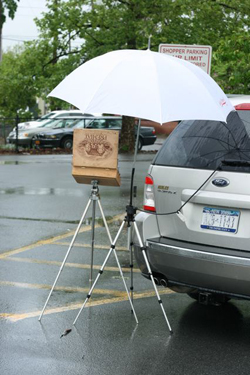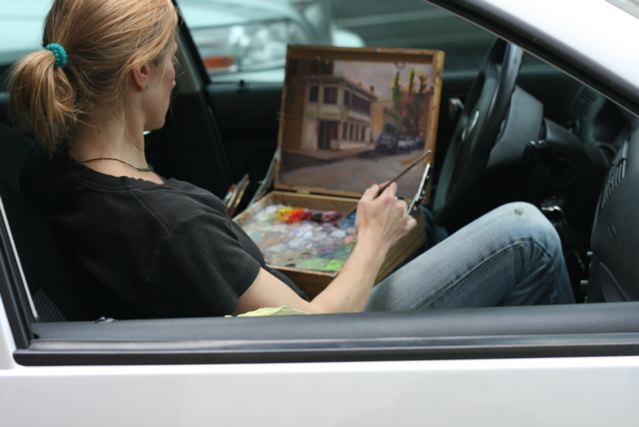FEATURING
Stories
The New Jersey State Botanical Gardens
- Details
- Written by Teresa Edmonds Teresa Edmonds
- Category: Home and Garden Home and Garden
The New Jersey State Botanical Garden at Skylands is a rare gem in New Jersey, with its variety of flower and tree species, gorgeous landscape and a Manor House which, going together, complement each other in local history and beauty. Cherry trees, beeches, lilacs, crab apple trees, wildflowers, oaks – the garden is rich with a diversity of tree and plant species. This was the intention of Clarence McKenzie Lewis, an investment banker and a New York Botanical Garden trustee. When he bought the Skylands property in 1922, he wanted to revamp the estate into a botanical showplace. To this end, he recruited the leading landscape architect of his time, the firm Vitale and Geiffert, for this job.
Some of the trees in the NJBG are over a century old, and there are species that are native only to the NJBG which grow nowhere else, like the Skylands spruce, the Oriental spruce, and the climbing hydrangea, which are found on the outside walls of the Manor House.
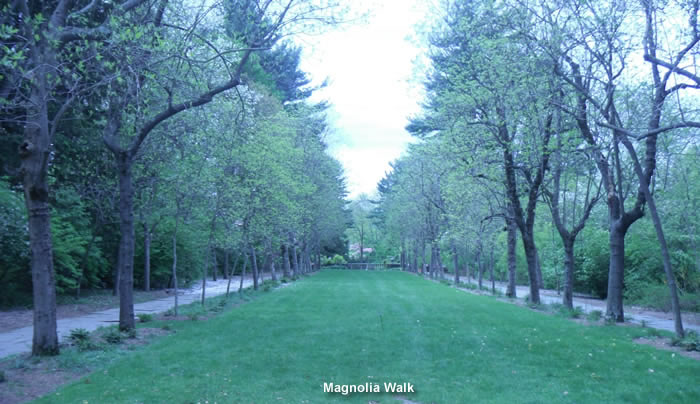
It was a cloudy day when I visited the New Jersey Botanical Garden (NJBG), but not so cloudy that the lack of sunlight obscured the garden’s beauty. Putting up with a noisy mulch truck in the background, which was there grinding tree branches into mulch, I set out on the approximately 1½ hour tour with the Princeton Historical Society, a group of 31 people that was also visiting the garden.
Leading the tour was NJBG/Skylands Association volunteer Sonja Vieth. She lives in Ringwood, NJ, where the NJBG is located. NJBG is one of the lovely attractions in Ringwood State Park, which is nestled in the Ramapo Mountains.
The NJBG/Skylands Association is a non-profit group that works toward preservation of the garden and the Skylands Manor, and educates the public on these historic features. Volunteers replicate the garden blueprint Lewis had envisioned, planting the same species and trees Lewis had planted for the Botanical Garden.
A brief history
The Skylands property was first owned by Francis Lynde Stetson, a high-flying New York attorney and a New York Botanical Garden trustee, who pieced together his property from farmsteads and named it Skylands Farms. Besides gardens, the Skylands property featured a nine-hole golf course, Stetson’s mansion and a functioning farm.
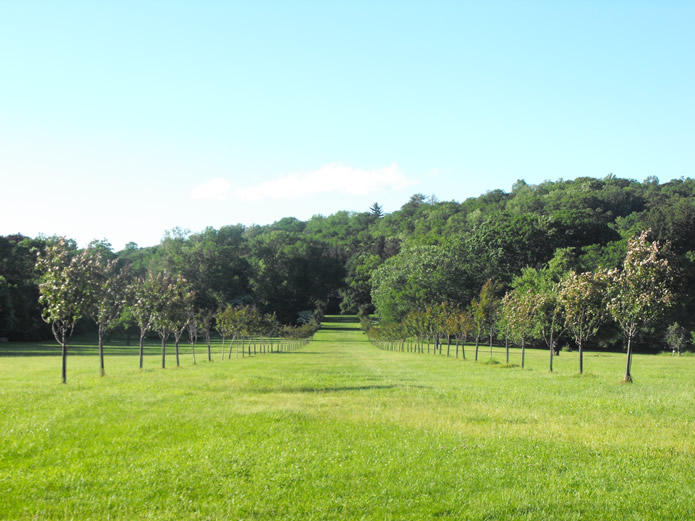
To design the Skylands property, Stetson entrusted the task to Samuel Parsons Jr., New York City parks commissioner and founder of the American Society of Landscape Architects. Parsons planned out the grounds, drainage systems and roads.
Luminaries of Stetson’s day that graced Skylands property with their presence included U.S. President Grover Cleveland, industrialist Andrew Carnegie, actress (and Drew Barrymore’s great-aunt) Ethel Barrymore and financier J.P. Morgan.
In 1922, Clarence McKenzie Lewis purchased Skylands. As I said before, Lewis envisioned the estate as a botanical showplace, travelling all over the state and abroad for three decades to bring the garden to life. He had Stetson’s mansion torn down and in its place had erected the current Manor House.
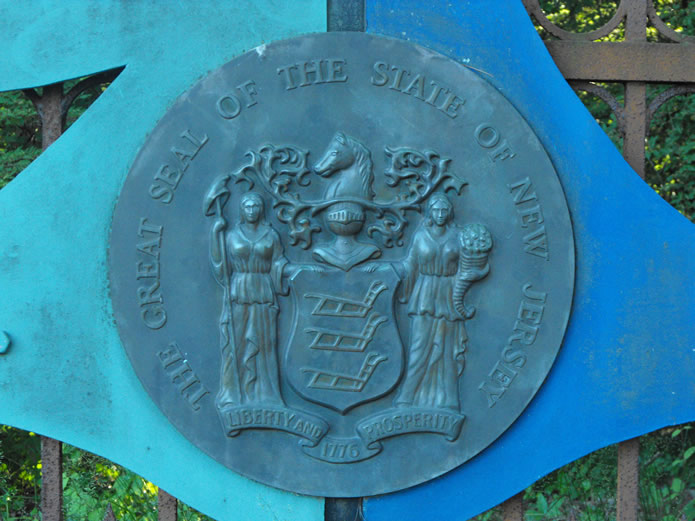
In 1966, the NJBG became the first property acquired under the NJ Department of Environmental Protection (DEP) Green Acres, which works to preserve open space all over New Jersey. In 1984, Governor Thomas Kean designated the central 96 acres surrounding the manor house as the state’s official botanical garden. It has been placed on the state and National Registers of Historical Places.
The tour
Each garden in the NJBG has highlighted trees and flower species, from the silver mountain bell tree (Halesia monticola) in the Azalea Garden, to over 100 different varieties of lilacs in the Lilac Garden.

The tour kicked off by visiting the Winter Garden, located behind Skylands Manor, where the weeping beeches are located. One parent weeping beech tree, which had been cut down at the base of the trunk and fenced off to keep children out, had given offspring to a whole family of weeping beeches in this garden.
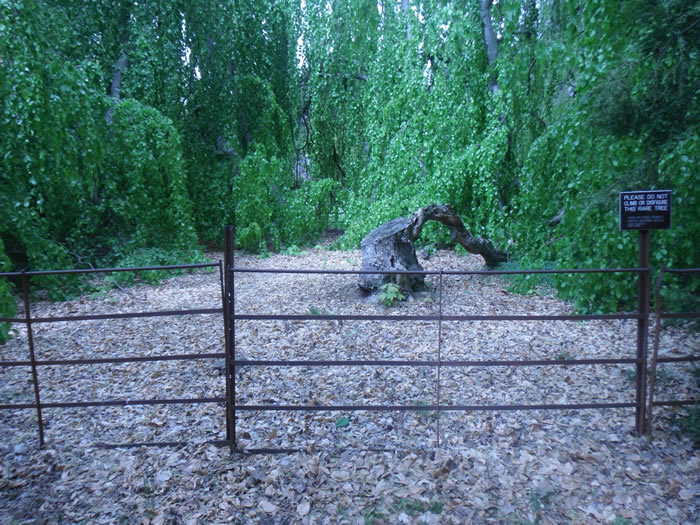
The Winter Garden is also home to the state’s largest Jeffrey pine (Pinus jeffreyi), the Japanese umbrella pine (Sciadopitys verticillata), and the North African Atlas cedar (Cedrus atlantica).
“His (Lewis’s) favorite thing was trees,” Vieth said. “Whenever he saw one on his travels, or he saw one in the catalogs, he said, ‘I’m taking one.’ That’s why there’s such a great variety of trees up here. He enjoyed them. And if it had the slightest chance of surviving in this area, he brought it and crossed his fingers. And most of the time, it worked.”
The Winter Garden is named as such because from his office, Lewis noticed the different shades of green –evergreens – of the trees here, Vieth said.
Developed by Lewis, the Skylands climbing hydrangeas scale the outside walls of the Manor House. The house itself was designed in the mid-1920’s by notable American architect John Russell Pope; however, the edifice was purposely created to look centuries old. Ripples were shaped into the Manor House’s rooftop for this reason.
The Octagonal Garden has all miniature and dwarf plants and features the Octagonal pool. The Magnolia Walk is a stretch of magnolia trees – native to the Carolinas – outside the breakfast room of the Manor House. Lewis planted the magnolias outside this room so scent can be carried to the room.
We also toured the famous crab apple allée, which features two long rows of trees that blossom pink at this time of the year. The rows extend from one end of the NJ Botanical Garden to the other end.
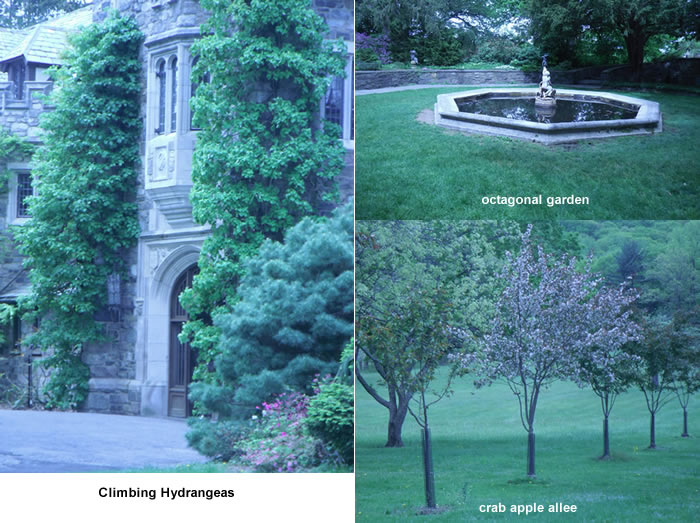
The tour leader of the Princeton Historical Society, Judy Marks, believed the tour was satisfactorily done.
“You always wish there was more detail, but it was well done,” she said.
Perhaps pictures aren’t enough to justify the beauty of the Botanical Garden. See for yourself what the gardens have to offer. Tours are held in the garden every Sunday at 2 p.m. Visitors can also go on a self-guiding tour with an information-rich pamphlet found at the Carriage House, where the tours start.
The NJ Botanical Garden is open every day from 8 a.m. to 8 p.m. Garden admission is always free. There is a $5 per car parking fee on summer weekends and holidays. Weekday parking is free.
Calendar Dates for the NJ Botanical Gardens
- July 8 (Friday), 7:00 pm
Concert: Loretta Hagen. Folk music at its best from this popular local star. Bring a lawn chair; concert moves to the Carriage House in bad weather. $5 donation requested.
Sponsored by NJBG. - July 9 (Saturday), 10 am
Black Bears & Aversive Conditioning. [GS] Has a black bear wandered into your yard looking for food? Nature educator Russell Brust will introduce you to black bears and ways to keep them safely away from your home with Aversive Conditioning. Donation requested. - July 17 (Sunday), 1 pm
Family Woodland Walk. Rich Cahayla-Wynne leads an easy, kid-friendly walk to learn about the nature around you. Wear sturdy shoes, meet at Carriage House. Rain cancels. FREE. - July 22 (Friday), 7 pm
Concert: Brassworks. From classical to ragtime, this group shows off what a group of horns can do. Bring a lawn chair; concert moves to the Carriage House in bad weather. $5 donation requested.
Sponsored by Coachworks.
Teresa Edmond is a journalist and poet living in North Jersey. Visit her blog, teresaedmond.com.
An Artist's Inspiration: Landscapes of Warwick's Village
- Details
- Written by Janet Howard Fatta Janet Howard Fatta
- Category: Art and Photography Art and Photography
In May, 2011 Janet Howard-Fatta begins her plein air painting series in the village of Warwick...
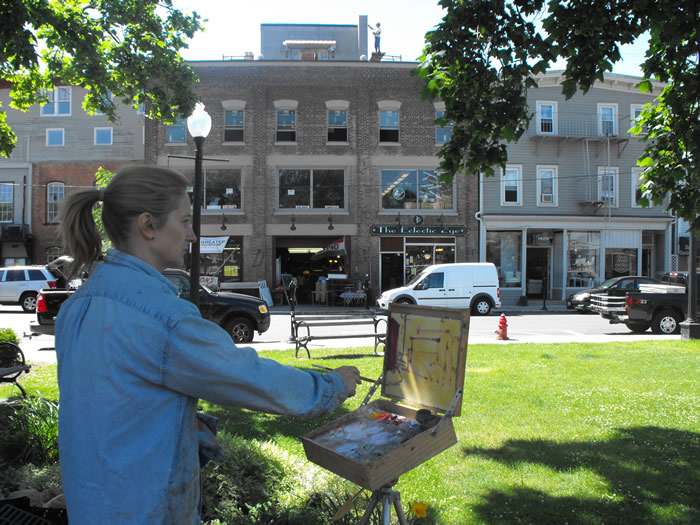
Janet painted in all kinds of weather conditions. She writes:
I have found out that my umbrella is only water resistant, not waterproof.
Today I painted in the car, (inspired by a fellow AIP member that I met at our event in Nyack, Crista Piscano). I sat in my car on Main Street, luckily my husbands car has a sunroof, and allowed me to sit in the light and paint. The car has some serious tinted windows, so that cut down on some of the light. It was so misty out today, I awoke feeling damp and figured I try something new to avoid getting saturated.
The light kept changing with the density of the clouds and so I got a little indecisive with the color of the shadows, I could have worked on it 3 more hours.
My friend Matthew came by and took a shot of me, I wasn’t quite finished with the painting at this point. I really want to paint Akins in the evening when those aluminum letters pick up all the colors reflected from the setting sun. Another day…
Janet kept a journal recording her thoughts...
10 reasons why I love painting outside in the Village of Warwick.
10. My palette staying wet and not wasting any paint.
9. The feeling that I am capturing a moment in history, it seems important.
8. The aroma of delicious food wafting through the air.
7. The unexpected gift of getting a jump start of my summer highlights in my hair.
6. Watching the light shift and change at different times of day and how that affects color.
5. Seeing all my different artist friends around town, there are so many of you.
4. Meeting new friendly people on the street.
3. This goal has caused me to have a huge excuse of why there are dirty dishes in the sink and the laundry not done.
2. The feeling that I can’t stop painting, That it is something that I have to do everyday.
It is so hard to choose the #1 reason, there is part of me that wants to say it is Cappucino Crunch ice cream cones at Cafe A la Mode, but the truth is I did not buy one of those cones, because I love it too much that I have to stay away.
1. The real # one reason is painting plein-air keeps me in the moment, in that power of now and makes me feel so alive and in tune to the world around me. It satisfies my intellectual connection to the history of art, the sound of the birds, fills my spirit and physically sets me up to be present. And those two hours that I spent outside recharges me in other areas of my life.
Here we discover her unique connection to the Village of Warwick as a special place and experience her process of making art...
I love antiques, I love architecture, and The Eclectic Eye is one of my favorite Warwick shops. I wanted to paint a store front, and I chose the eclectic eye because the store front is kind of like a visual musical grid to me. After I did a sketch, it was decided that this was the location for the day.
I stood on Railroad Green under the shade of a a huge Maple. I met the man who welded Fredrick Franck’s sculptures for 22 years, he enchanted me with his stories while I painted.
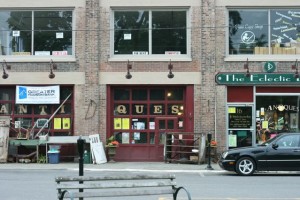
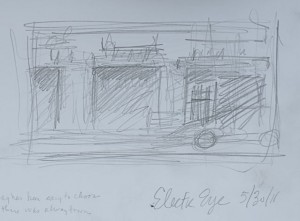
At first, I look and keep looking, mixing up colors before I paint. I find my lights in warm and cold tones, and my darks in warm and cool tones, and local colors – on the dark side. Then I begin to apply paint, usually in blocks of color. Sometimes I start with pure color, and sometimes I start with dark shadows. Here the dark shadows helped define the space. I took photos along the way, and made a progression semi-slide show of the development of this piece.
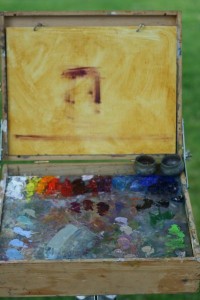
When I was done, I realized it was Sunday Morning, and I recalled Edward Hopper’s Sunday morning. How very Ironic. And I laughed and said it was a Janet Hoppard, how cliche and ridiculous, but it made me laugh!
From Sept 1 -30, 2011, Janet featured those plein air paintings and presented them as part of an exhibition at the Albert Wisner Library entitled An Artist's Inspiration: Landscapes of Warwick's Village and Town.
Janet writes: "For me as an artist, this is about looking deeper at a place, past the pretty scenery, experiencing it and capturing a fleeting moment. It is also the art of finding beauty everywhere and about possibility. I was very inspired by the Edward Hopper Exhibit this winter at the Whitney. Warwick has that quaint, wholesome character that is typical in Hopper's work. Through the use of color temperature, light and atmosphere, I'm hoping the unique sense of Warwick can be experienced through my paintings. In spring a whole new breath gets cast into the air in the Hudson Valley with blossoms and farmers markets and I was delighted to be outside painting in it with people on the streets of Warwick. It is a fantastic place to live.
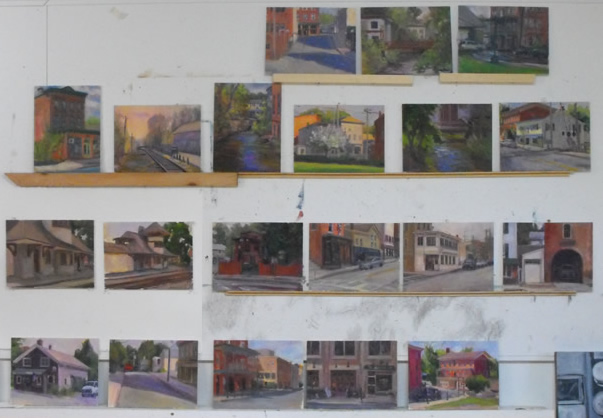
 Hudson Valley artist Janet Howard-Fatta creates a variety of works from landscapes in oil depicting place and time, to figurative works in wet and dry media. Light, color and a love of nature are the driving forces behind her work. Janet's work reflects a relationship between the world around her and the painted image. She strives to create a visual representation of what she experiences through her senses. Janet is a Pratt Graduate, currently a board member of Artists in the Parks, and facilitates the Warwick Life Drawing Group. She lives in Warwick, NY with her husband and two children.
Hudson Valley artist Janet Howard-Fatta creates a variety of works from landscapes in oil depicting place and time, to figurative works in wet and dry media. Light, color and a love of nature are the driving forces behind her work. Janet's work reflects a relationship between the world around her and the painted image. She strives to create a visual representation of what she experiences through her senses. Janet is a Pratt Graduate, currently a board member of Artists in the Parks, and facilitates the Warwick Life Drawing Group. She lives in Warwick, NY with her husband and two children.
To read a previous story about Janet Howard-Fatta, we recommend our feature story Fine Arts, Finding Balance and Family Life with Artists Janet and Louis Fatta. Includes video coverage of Louis Fatta's artmaking process.
To purchase Janet's book of paintings about the village, click here.
To purchase Janet's notecards, visit her website and Postal Plus in New Milford.
For more info about her Upcoming Exhibit: Trailworks Holiday Exhibit "Good Things, Small Packages"- November 12th-January 8th, 2012 click here
Janet will be offering a spring Plein Air Painting Workshop - Saturday, April 21-22nd, 2012 - 9AM-2PM. For more information, click here.
Gluten-Free Apple Crisp
- Details
- Written by George L. Nitti George L. Nitti
- Category: Home and Garden Home and Garden


Apples from Warwick Apple Orchards, including Masker Orchards, Applewood Orchards and Winery, Appleridge Orchards, Ochs Orchard, Pennings Orchard and Farm Market, and Warwick Valley Winery and Distillery.
Sustainability: From Science to Art Form
- Details
- Written by George L. Nitti George L. Nitti
- Category: Home and Garden Home and Garden
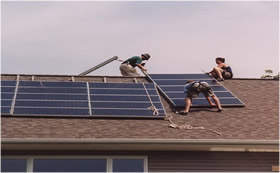 Warwick residents William and Mary Makofske have a passion for living sustainably, setting a sterling example while sharing their enthusiasm with others. Bill with a Ph.D. in physics has spent his life working on energy alternatives, both teaching and putting into practice his knowledge. As a professor emeritus, and having taught a variety of environmental courses, he is well versed on the environmental impacts of energy consumption, the benefits of renewable energy, and green building. Mary, a poet and former English Professor shares his passion, helping to create a lifestyle in which sustainable living is at the forefront. Between the two of them, Bill’s pursuit of turning sustainable living into a science and Mary’s into some kind of art form, the two have emerged as shining examples of what it means to be energy conservationists.
Warwick residents William and Mary Makofske have a passion for living sustainably, setting a sterling example while sharing their enthusiasm with others. Bill with a Ph.D. in physics has spent his life working on energy alternatives, both teaching and putting into practice his knowledge. As a professor emeritus, and having taught a variety of environmental courses, he is well versed on the environmental impacts of energy consumption, the benefits of renewable energy, and green building. Mary, a poet and former English Professor shares his passion, helping to create a lifestyle in which sustainable living is at the forefront. Between the two of them, Bill’s pursuit of turning sustainable living into a science and Mary’s into some kind of art form, the two have emerged as shining examples of what it means to be energy conservationists.
 One might say that living more sustainably starts with the basic foundations. For the Makofske’s, that was the case – who have been taking into account basic solar and energy efficiency principles from the inception of building their home. “When we built our home in 1998, we had a clear vision on where we wanted to go,” Mary states. “The compass we used determined the design of our house.” Quite literally, that is. The house is oriented to the south, with most of the windows and a greenhouse on the south side. The south roof has both solar electric and solar hot water panels. The building is airtight, highly insulated, with an air-to-air heat exchanger to bring in just the right amount of fresh air. They also found other ways to conserve energy, such as reducing the thermostat at night, and covering their windows with movable insulation to retain energy.
One might say that living more sustainably starts with the basic foundations. For the Makofske’s, that was the case – who have been taking into account basic solar and energy efficiency principles from the inception of building their home. “When we built our home in 1998, we had a clear vision on where we wanted to go,” Mary states. “The compass we used determined the design of our house.” Quite literally, that is. The house is oriented to the south, with most of the windows and a greenhouse on the south side. The south roof has both solar electric and solar hot water panels. The building is airtight, highly insulated, with an air-to-air heat exchanger to bring in just the right amount of fresh air. They also found other ways to conserve energy, such as reducing the thermostat at night, and covering their windows with movable insulation to retain energy.
As they have found more ways to conserve energy, correspondingly their savings have multiplied. Bill points out that they have not had to pay an electric bill for some time, although occasionally in the winter there is a small one. Noting that the average home might use 1200 gallons of oil a year, they have employed a variety of means to reduce that number to 100 gallons a year, envisioning a day in the not-too-distant future when their home will have achieved zero net energy.
Since 2003, as part of a national tour sponsored by the American Solar Energy Society, they have opened their home to the public, sharing their insights to help others who have the same desire to build an energy efficient solar home. Admittedly, I was naïve in my understanding about some of the issues surrounding ‘the sustainable home,’ thinking that I was going to walk into a home simply powered by wind, water and sun.
But I learned that their energy source, on a sunless winter day, is generated not from solar, but in part from their back-up oil burner. After all, we all know that Warwick, NY is not Arizona in terms of the sunshine factor. It’s the cumulative effect - from creating a solid efficient house to employing several energy systems to one’s everyday actions – that allows for cost reductions. And it starts with the basics, the not so glamorous side of conservation like weather stripping or super insulating your home, which Bill has given workshops on. Otherwise, “your house is like a sieve,” says Bill. “You can reduce heat loss significantly when you insulate properly, make it airtight, and employ air exchange systems.” These measures alone have saved them approximately 700 gallons of oil a year.
Like the homes of the ancient Anasazi Indians built facing southward to capture the warming benefits of the sun , so too is the home designed with conservation in mind. “The sun plays a primary role in supplying our energy needs,” says Bill. “Two-thirds of our windows, which represent over 8% to 10% of floor space, were installed on the south side of the house. Because the sun sits low in the south sky in the winter, south sloped roofs and windows will collect energy.” For those renovating or looking to buy an existing home, this is not a moot point. Bill calculates that due to the 200-square-ft. of windows facing their south side, they are able to save 200 gallons of oil a year because “each square ft. gains us a gallon of oil in terms of heat. When you do this, there is absolutely no extra cost.”

Adding a green house on the south side of their home also cut energy costs. “When the greenhouse door is left open on sunny days, it transfers heat to the house. Heat rises by natural convection and makes our house warmer.” Bill estimates that their greenhouse has saved them another 100 gallons of oil a year. On the winter day that I went, they were growing multiple heads of lettuce in February. At a $1.99 a head, I was calculating the savings to myself. Mary states, “obviously you can grow things in a greenhouse when normally you can’t.” Later in my tour, they showed me their perfectly cooled storage room, containing baskets of fresh garlic, leftover from the late summer months, plucked from their garden. And I might add, it wasn’t any old garden – it was a large plot of land.
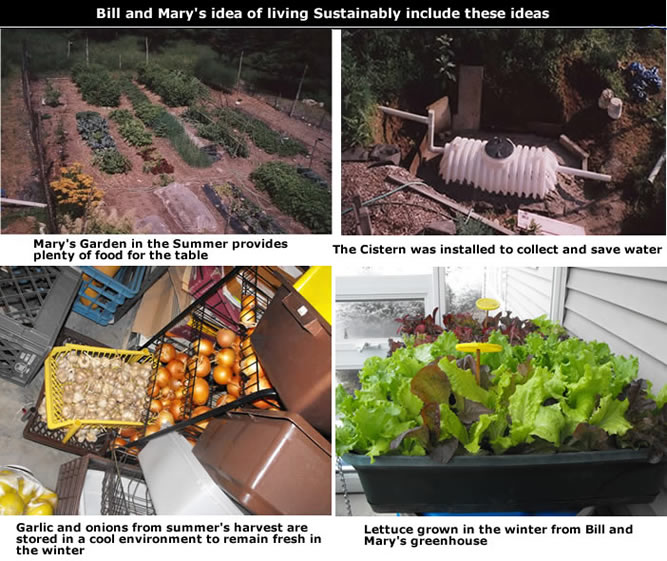
Other measures, such as reducing the temperature at night, have brought down their energy costs further. Although commonsense, not everyone applies it. “For every degree you drop the thermostat, you save 2% on the cost of energy. Dropping the temp down from 68 to 60 an average of 8 hours a day over the course of the winter may yield you approximately 10% of your total energy costs. Not only do you save energy, but it is healthier for you, because it keeps the humidity higher, clearing out those nasal passages.”
The kind of windows installed may impact energy savings as well. For example, if you want windows that transmit more sunlight, then you have to accept that in winter, you may lose more heat from those windows. Their home uses double-paned windows with a low-emissivity coating , giving it a higher R Value. R is a measure of resistance to heat flow, so the higher the better. The extra R-value more than compensates for the drop in light transmission. But as he says, “you have to balance it - weigh each of these factors and make a decision.”
Bill and Mary were among the first people in Orange County to take advantage of the incentives and rebates provided by the federal and state government to add solar photovoltaics to their home. “I was waiting for the law to pass,” Bill says with relish as if a kid speaking about Christmas Day. But then he notes that it is a significant investment, one in which rewards are not reaped until further down the road, even with the approximately 50% government rebates. “A PV system may take 8-10 years to pay back, but it will likely last for 30 years.” The solar hot water heater was installed for $3000 when the house was built before tax incentives existed. All told, the solar PV, hot water heater, greenhouse, added insulation, and air to air heat exchanger cost less than $30,000, or about 15% of the cost of the house. Payback time varies for each of them, but they all pay back in less than 10 years.

Some people are not prepared to make that initial investment, nor are they certain they will be living in that home for the foreseeable future.” However, the investments make the house worth more at time of sale, since energy costs keep rising faster than inflation. In discussing other obstacles, public misperceptions are a factor. Mary says, “A lot of people don’t think it works, or that it is for people with fancy houses, or that it’s not practical. Or people will say ‘I can’t afford to buy solar panels.’ Yet those granite counter tops go in.” Bill adds, “There’s an investment. But the energy systems will last 30 years. It’s like building a power plant – not everyone is interested in building a power plant.”
 Their solar PV unit has provided them not only with savings, but a surplus of energy. While they pay a monthly connection fee of around $10, they are credited for excess energy, measured by a meter, something which Bill refers to as net-metering. Overall, the surplus is also applied on occasion to several electric heaters and to back up their solar water heater. These investments along with continued conservation mindedness have saved them approximately $5000 a year on their home energy costs. Living in their home for 11 years, those savings add up – to approximately $55,000. Since their new energy systems won’t need to be replaced for another 10 to 15 years, that’s money in the bank.
Their solar PV unit has provided them not only with savings, but a surplus of energy. While they pay a monthly connection fee of around $10, they are credited for excess energy, measured by a meter, something which Bill refers to as net-metering. Overall, the surplus is also applied on occasion to several electric heaters and to back up their solar water heater. These investments along with continued conservation mindedness have saved them approximately $5000 a year on their home energy costs. Living in their home for 11 years, those savings add up – to approximately $55,000. Since their new energy systems won’t need to be replaced for another 10 to 15 years, that’s money in the bank.
Yet success is not just measured in dollars and cents, but by other measures, such as environmental impacts and carbon footprints. Bill says, “People are not aware that when they use electricity, most of that electricity comes from coal-fired plants. Although it seems clean at point of use, the reality is that there is a coal plant belching out lots of CO2 into the environment.” When I inquired why a wood burning stove was not part of his overall strategy, he explained his concern with air quality in a tight house “wood smoke is toxic. Plus, it’s work to cut wood, clean ashes and fire up the stove. I’m not against using wood, but the more clean energy that is produced, the better.”
In terms of outreach, the two have participated in meetings involving Warwick’s efforts to find ways to reduce their carbon footprint. When told about Maplewood, N.J’s successful efforts to reduce energy use, they met with their mayor, along with various representatives from Warwick’s town and village government and several other key organizations to compile suggestions, one of which was creating a bike path, spearheaded by Sustainable Warwick. Bill has continued to be active with the town, as they have drawn on his expertise. In 2011, he was instrumental in shaping and writing a successful grant involving the purchase of 3 hybrid school buses and two electric charging stations, which have now been successfully installed in the village and the town and are being used to charge-up a new breed of electric vehicles like the Chevrolet Volt.
Mary too has not let up her efforts. One project involved using window mannequins to publicize the 350.org campaign to set a goal for 350 ppm carbon in the atmosphere. Mary says, “We gave out flyers, collected petitions, and paraded in a dragon costume downtown. The idea was to put pressure on the U.S. to push for a strong commitment at the climate conference in Copenhagen”(which she points out we didn't get). Mary was also directly involved in developing a reusable bag campaign in conjunction with Shop-Rite. Then there is the 10% Challenge, a program implemented by Sustainable Hudson Valley, which could also reduce the community’s carbon footprint. Mary says “The idea is to get existing groups to sign on to reducing some form of their energy use by 10% in one year. It's partly just raising awareness, encouraging people to see where their energy goes and how they can reduce it.”
Mary, who is a published poet, reflects those sustainable values in her writing.
Dear Editor
The light tracks me all day, sitting at my desk,
late afternoon now. Air holds its breath,
barely a tremble in the fountain grass,
the box elder leaning against the glass,
a small plane droning low over the hills.
Does it seem leisurely? Does all seem well?
Today I composed more and more
fervent letters to the editors
of every local paper, why it must change,
why we must think who we are, as the same
that is never the same turned over leaves
that flamed or quietly browned. What dies,
what thrives in the garden every year
is different, unpredictable. Our share’s
enough, we can’t change the weather,
we used to say, though now we know better.
Too late moves toward us faster
than the fast-retreating glaciers.
Published by Amoskeag.
Clearly, there is a lot to learn from the Makofskes, who have taken knowledge of natural energy flows and turned it into a lifestyle art form. Which all adds up to living in a better, cleaner world. Still working to reach a better score, however, this couple is not resting on their laurels, nor sitting tight in their fuel efficient Toyota Prius. They are the first to learn from their experiments, always seeking improvement, both in their personal progress and the world they will leave to the next generation.
Thank you Bill and Mary.
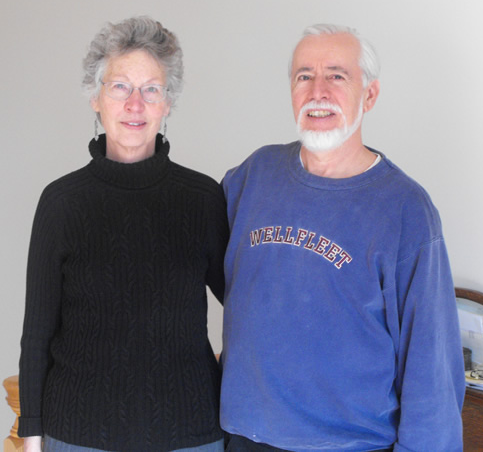
Breezy Point Inn: Combining Authentic German with American Cuisine
- Details
- Written by George L. Nitti George L. Nitti
- Category: Food & Wine Food & Wine

On Oct. 16th, 2011, Kerryl and I went to the Breezy Point Inn to celebrate Octoberfest, which runs every Saturday and Sunday in the month of October, and which has been extended through Nov.5 and 6th. There are three seatings – 1, 3 and 5PM - take your pick and make a reservation. We tried for 3PM, but the restaurant was booked at that time, so we had to settle for a later seating. I hadn’t had German Food in quite a while and my taste buds were ripe for an authentic German experience such as their incredible assortment of sausage (see the wurst family), slow roasted pig and red cabbage. Not to mention apple strudel and a classic German brew. After taking a look at their all-inclusive buffet menu the day before, I concluded that for only $25, this might be the best bargain in town and planned a date with Kerryl.
No stranger to the Breezy Point in Greenwood Lake where I've been a resident for nearly 5 years and visitor for over twenty, I have had many unique experiences eating lunch or dinner on their deck looking out over the expanse of lake with gorgeous views enveloped by scenic mountains. I almost feel like I’m on Lake Como in Italy, for much less the price. It’s romantic and somewhat intoxicating when you are looking out at this beautiful lake, having a drink, enjoying fine food and sharing the company of friends and family.
This past year I was at the Breezy during their Winter Carnival in February, their Classic Antique Boat Show in June, a business mixer with the Warwick Valley Chamber of Commerce in spring, and lunch and dinner on several occasions throughout the year. Each experience was joyfully different – from the chili tasting contest of Winter Carnival to intimate dining with Kerryl when we enjoyed a grilled rib-eye steak and horseradish encrusted Atlantic Salmon. Other favorites have included their generous spinach salad, weighty burger and fries, tender filet minion, and "to go back for" crispy jumbo coconut shrimp. And should you be hankering for their traditional signature German dishes, you know that year round, you will find Schnitzel Holstein (pan-fried breaded veal), Sauerbraten (braised red wine marinated beef), and Eisbein (braised knuckle of pork), amongst just a few of the specialities appearing on their menu.

During Octoberfest, on a clear autumn day, with the sunshine reflecting off of glistening water and foliage turning deeper hues of auburn and crimson, not only will you brighten with fall's intense colors, but from the food and upbeat oom-pa band played by Werner. You will be impressed by the ample spread of food - the variety of cheeses, the bavarian barley soup, the artisanal breads and array of meats and vegetables that grace the buffett table, more than enough to compete with any courtly feast. Breezy's German food roots clearly make this Octoberfest a frontrunner of all of the Octoberfests' in the region. You know the food is good, not only when it tastes good, but when everyone around you is speaking German or another foreign language.
The Breezy is a great destination for its waterfront and top knotch lake and mountain views, consistently great food, and its fun and festive atmosphere. When you come to the Breezy, you will feel like you are on vacation without having to take the plane ride to Italy. Or should I say Germany. Happy Octoberfest!
The Northeast Poetry Center: Class Reflections
- Details
- Written by Marina Mati with George L. Nitti Marina Mati with George L. Nitti
- Category: Education Education
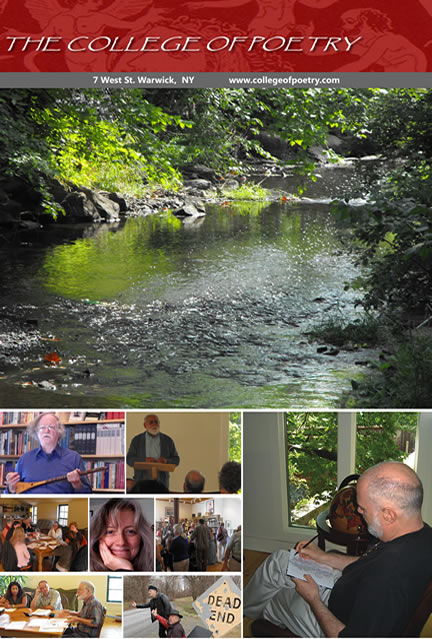 The Northeast Poetry Center at the College of Poetry located on 7 West St. in Warwick is a non-profit organization that has been conducting poetry workshops, classes and readings for over two years and was founded to serve individuals who share a passion for poetry.
The Northeast Poetry Center at the College of Poetry located on 7 West St. in Warwick is a non-profit organization that has been conducting poetry workshops, classes and readings for over two years and was founded to serve individuals who share a passion for poetry.
Before there was a College, poetry was one of the mainstay activities at this location, where poets came to read their verse and rhyme in an intimate bookstore setting. With the expansion of a backroom and the group efforts and vision of several individuals, the poetry center was forged.
William Seaton, whose organization Poetry on the Loose has offered a monthly reading series for nearly twenty years, is one of the founding members of the Center and has helped shape a unique curriculum and vision, drawing on his many years of experience as a poet, teacher and facilitator of poetry. As has Robert Milby and Steve Calitri, two of the other founding members of the college. Milby is no stranger to the poetry scene, making his rounds throughout Orange County and beyond, leading at least a dozen readings a month. Steve Calitri, a publisher, poet and owner of the building where the center resides, has also contributed significantly, generously offering the use of the space and his experience to keep the center moving forward.
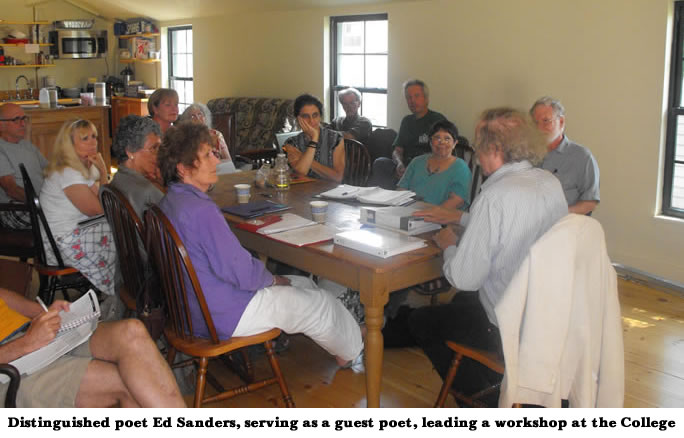
This summer marks the beginning of the 3rd season in which workshops have been offered by the college, with classes beginning July 9 and going through August 27th. William Seaton will teach a Saturday morning class entitled "The Poet’s Tool-Box: Figures of Speech and Thought," which will focus on the use of rhetorical figures, traditionally considered a distinguishing mark of poetry. The afternoon workshop, led by author and poet Donna Reis will meet from 1:30 pm – 3:30 pm is called "Writing from the Heart: How Personal is Too Personal." The class will explore twenty poets who’ve mastered confession and disguise, emotion and distance and will discuss their different levels of personal involvement and the strategies they used to reveal or not reveal. Each discussion will be followed by a writing exercise where students will practice the techniques discussed.

To find out what to expect from a class, here is a summary provided by student Marina Mati, who took a class in 20th Century Latin American Poetry.
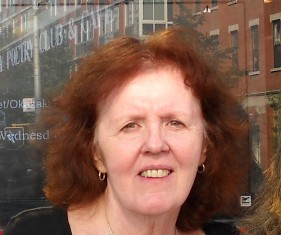 Janet Hamill, the instructor for 20th C. Latin American Poetry at the NE Poetry Center, is a well-established poet/performer dedicated to poetry and its history. For our first class we received a bibliography of anthologies, introductions and histories. There was a short list of poets which included the 3 greats: Pablo Neruda, Octavio Paz and Cesar Vallejo. The rest of the "short" list included 30 others, including Che Guevera. We were introduced to the historical context of that century in Latin America. (Janet provided a map to assist the visually curious.) The wars of liberation were freeing South America from Spanish colonialism and the poets wanted their own language and culture. This is the beginning of the earthiness and sensuality Latin American surrealism is famous for. The poet in the vanguard who named the movement Modernismo in 1890 was Ruben Dario (accent on last syllable of each name).
Janet Hamill, the instructor for 20th C. Latin American Poetry at the NE Poetry Center, is a well-established poet/performer dedicated to poetry and its history. For our first class we received a bibliography of anthologies, introductions and histories. There was a short list of poets which included the 3 greats: Pablo Neruda, Octavio Paz and Cesar Vallejo. The rest of the "short" list included 30 others, including Che Guevera. We were introduced to the historical context of that century in Latin America. (Janet provided a map to assist the visually curious.) The wars of liberation were freeing South America from Spanish colonialism and the poets wanted their own language and culture. This is the beginning of the earthiness and sensuality Latin American surrealism is famous for. The poet in the vanguard who named the movement Modernismo in 1890 was Ruben Dario (accent on last syllable of each name).
According to Janet's handout, "The majority of Modernist poets were concerned with expressing eternal values in contrast to the transitory aims of a temporal world. At the same time they wanted a sensual poetry that could give voice to all the experiences which had never been put into poetry. Sexual love and sensuality in the poetry of Latin American Modernists was something completely new." They sought "the triumph of the beautiful over the didactic". To remedy the "iron molds" of colonialism, they wanted to "new spirit" of their poetry to include" the infusion of color, life, air and flexibility". This is the movement that predates the 3 great poets, especially Neruda considered the "greatest poet of the 20th century in any language" by Gabriel Garcia Marquez.
Here is the last verse from a poem called Ecstasy (Extasis) by Modernismo poet Amado Nervo (1870-1919) from Bolivia:
I want passionately to be immortal,
because it is marvelous, the panorama
that invites us to immense creation;
because every star calls to me,
saying with brilliant light, "here, also,
they think, here they struggle, here they love.
The Modernists saw art as "an adventure into the absolute...a mystic way to knowledge...as part of a deeper spiritual crisis.” Janet's knowledge is rich and she tirelessly prepares for each class.
We also had samplings from Ricardo Jaimes Freyre, Leopoldo Lugones, Julio Herrera Y Reissig and Delmira Agustini. Janet provided pictures of them on 8x10's and a biographical information for each. For instance, in Agustini's bio we learn that she was an "early spokesperson in Latin American letters for the autonomous energy of female consciousness." Their words and lives moved us.
The class ended, as all classes do with a writing exercise that used the symbols popular with the Modernists: the swan, peacock and stars to express the ineffable or beauty, eternity or melancholy among others.
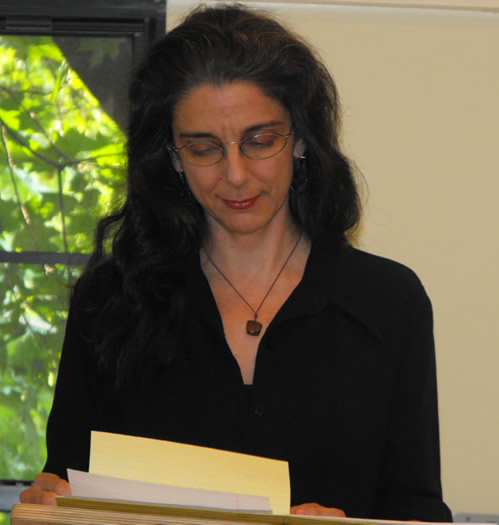 Marina Mati, a.k.a. Marina Penzner, a poet and actor, has lived in Orange County since October of ’98. Native to New York City, she was frequently featured throughout the tri-state region. She wrote, directed and appeared in her performance poetry at the Alchemical Theatre. At Speakeasy in Greenwich Village, she co-produced and hosted a weekly poetry reading that featured Hal Sirowitz and Sapphire. Publishing credits include the East Village’s Downtown; two issues of The National Poetry Magazine of the Lower East Side; Calling All Poets: the featured readers 2002-2003; The Company We Keep, Poet Warrior Productions and The College of Poetry Anthology First Annual. Featured readings here in the Hudson Valley have included Colony Cafe in Woodstock, Bergen County Community College and the Howland Center in '03. A frequent feature of John Pietaro and The Flames of Discontent's social justice events like the Dissident Arts Fest in Beacon and NYC, she was also featured at the Anti-Fracking event in May of 2011 at the Howland Center produced by Chris Ruhe.
Marina Mati, a.k.a. Marina Penzner, a poet and actor, has lived in Orange County since October of ’98. Native to New York City, she was frequently featured throughout the tri-state region. She wrote, directed and appeared in her performance poetry at the Alchemical Theatre. At Speakeasy in Greenwich Village, she co-produced and hosted a weekly poetry reading that featured Hal Sirowitz and Sapphire. Publishing credits include the East Village’s Downtown; two issues of The National Poetry Magazine of the Lower East Side; Calling All Poets: the featured readers 2002-2003; The Company We Keep, Poet Warrior Productions and The College of Poetry Anthology First Annual. Featured readings here in the Hudson Valley have included Colony Cafe in Woodstock, Bergen County Community College and the Howland Center in '03. A frequent feature of John Pietaro and The Flames of Discontent's social justice events like the Dissident Arts Fest in Beacon and NYC, she was also featured at the Anti-Fracking event in May of 2011 at the Howland Center produced by Chris Ruhe.
Her latest acting adventures have been in Lisa Kimble's plays, a talented local playwright, performing staged readings in Rock Tavern and Kingston at A.S.K.


